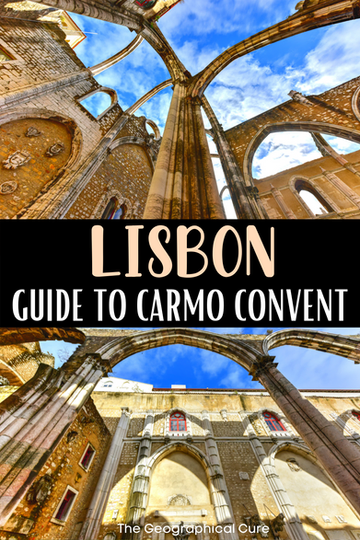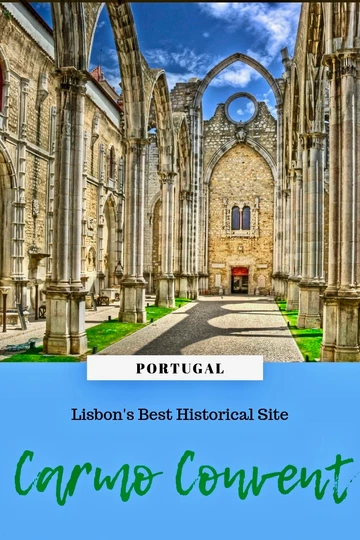Here’s my guide to visiting Carmo Convent in Lisbon Portugal.
Lisbon isn’t a city with grand monuments and squares like other European capitals. There aren’t that many truly “wow” sites in Lisbon. I know that sounds crazy, but it’s true.
The beauty of Lisbon lies more in its laid back artistic ensemble than in any specific sites — the sparkling azulejo clad buildings, the 30 something miradouros, the rickety trams, the cobbled alleyways.
The seven cinematic hills lording over the Tagus River are perhaps its most arresting feature. Lisbon’s sultry, a place with an abundance of culture, color, and endless panoramic views.
But one site entranced me on my recent geographical cure: the haunting ruins of the Igreja do Carmo, aka Carmo Convent. I think it’s Lisbon’s best historical site. It’s an undisputed wow, a must see historic and cultural site in Lisbon.
How To Get To Carmo Convent
To get to the Igreja do Carmo, take the neo-Gothic Santa Justa Elevator in Baixa, also known as the Carmo Lift. The elevator was opened in 1902 and is now a National Monument. The wrought iron lift was designed by Raoul Mesnier, a student of Gustave Eiffel. It was originally intended to help the locals navigate Lisbon’s hilly streets.
The elevator, located on Rue do Ouro, connects the lower streets of Baixa to the Largo do Carmo square in the Chiado neighborhood. Google says it’s open at 7:00 am. It opened promptly at 7:30 am when I went, and that’s what the site’s signage says too. So be forewarned.
Alternatively, you can take the green or the blue metro line to the Baixa/Chiado stop. Or hike up. There’s plenty of hiking to be had in Lisbon.
In the Largo do Carmo square, reached via a walkway from the lift, you’ll find the entrance to the Carmo Convent ruins and the museum. The square, by the way, seems to be one of Lisbon’s trendiest hangouts. Its terraces are right in front of the church and provide cocktails with views.
History of Carmo Convent
The Carmo Convent was founded in 1389 by Portuguese knight Nuno Álvares Pereira. Pereira had won the favor of the King of Portugal, João I, after a great victory in 1385 that helped ensure Portugal’s independence from Spain. As a result, he became quite wealthy.
With the king’s support, and in an act of intense dedication, Pereira donated all his money to build a church. He retired from the military and became a full brother of the Carmelite Order.
Built between 1389 -1423, Pereira’s foreboding and rather bleak creation, the Igreja do Carmo, was once Lisbon’s most important church. It had an immense library with 5,000 books.
But on November 1, 1755, a deadly 8.9 decibel earthquake hit Lisbon and killdozed most of the city. The earthquake was followed by five days of fires and tsunamis. It was the worst day in Lisbon’s history. It would be in the life of virtually any city, for that matter.
To make matters worse, the church’s roof collapsed, killing hundreds who were gathered there for worship on All Saints Day. The library was destroyed. Estimates of 60,000 -100,000 citizens perished. Lisbon became a tent city for a time.
Some said that the holy day massacre was an act of divine retribution for the lewd lifestyles of the Lisbonites. Like Lisbon was a hotbed of villainy … French author Voltaire was ticked off at this “everything happens for a reason” fatalism. In Candide, the master of irony wrote: “if this is the best of all possible worlds, what are the others like?”
The church was never entirely rebuilt and intentionally left roofless. After the earthquake, the monks reinforced the damaged walls and did minor repairs. In 1800, the roof of the convent building was rebuilt. In 1864, the building was donated to the Association of Portuguese Archaeologists, who promptly created an archeological museum.
The romantic ruins remain today, as a memorial — a glorious shambles. It’s a strangely affecting place. The sky clad skeleton stands out against the seismically sound Pombaline architecture that the practical Prime Minister built after the earthquake.
Once inside the church, you’ll see evocative ruins. The church’s interior has a nave with three aisles and an apse with a main chapel and four side chapels. The walls are adorned with sculptures and the grounds are a bit of an architectural salvage yard.
But it’s the wishbone-like gothic arches set against heavy pillars that catch your eye. I’m used to gazing up at ornate ceilings and stained glass when I enter a church. Here, there’s none of that.
And yet I was transfixed by the sight of the delicate arches set against the vivid blue sky. I rather enjoyed them not being hidden under a roof, with faint sounds from the city flowing through. They are a fitting tribute to Lisbon’s suffering in 1755.
The Archeological Museum at Carmo Convent
The church features a small archeological museum dedicated to Portuguese history. It’s where the altar used to be.
The museum has an eclectic mishmash of artifacts, including sarcophagi, heraldic crests, statues, ceramics, and azulejos. There is a remnant of a Visigothic pillar and the tomb of King Ferdinand I. And two gruesome 16th century mummies from Peru.
Ferdinand’s bas relief tomb is particularly stunning. He designed it himself, and it bears the crests of his family. It also depicts religious and lay figures, groups of fantastic creatures, an alchemist, as well as scenes from the life of Saint Francis of Assisi. There’s even a hole in the tomb, made by Napoleon’s plundering soldiers.
A Peruvian girl mummy complete with teeth and hair. I could never really ascertain why she was in the Carmo.
If you like ruins more than reproductions, don’t just glance at Carmo in passing. This is your best historical stop in Lisbon. An ancient site, eerie and atmospheric, under a stark blue sky. Full of meaning, the cavernous shell of Carno Convent bears witness to the worst day in Lisbon’s history.
You may enjoy these other Lisbon travel guides and resources:
• Guide to the Alfama neighborhood
• Guide to the Belem neighborhood
• Guide to Jeronimos Monastery
If you’d like to visit Lisbon’s Carmo Convent, pin it for later.


